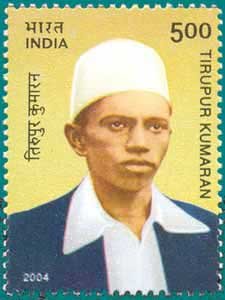Tirupur Kumaran (1904-1932)

Technical Data
| Stamp Set | Birth Centenary |
|---|---|
| Date of Issue | October 4, 2004 |
| Denomination | Rs. 5 |
| Quantity | 600,000 |
| Perforation | comb 13 x 13½ |
| Printer | Security Printing Press, Nashik |
| Watermark | No Watermark |
| Colors | Multicolor |
| Catalog Codes |
Michel IN 2049 Stamp Number IN 2077 Yvert et Tellier IN 1814 Stanley Gibbons IN 2223 WADP Numbering System - WNS IN035.04 |
| Themes | Famous people | Headgear | Men | Revolutionaries |
Table of Contents
Commemorative Stamp: Tirupur Kumaran (1904–1932)
Design Elements:
- The stamp features Tirupur Kumaran, holding the Tricolour, symbolizing his courage and nationalistic spirit. The background shows a crowd of protesters, evoking the freedom struggle, with the Indian flag prominently waving in his hands as a tribute to his heroic act of defending it.
Life and Early Years:
- Born on October 4, 1904, in a poor weaver’s family in Chennimalai, Erode District, Tamil Nadu, Kumaran’s early life was defined by hardships. His father, Nachimuthu Mudaliar, and mother, Karuppayammal, named him Kumaraswamy. Limited by poverty, he received only a primary education up to the fifth standard. At a young age, he trained in weaving, learning the trade from his uncle at Pallipalayam, a skill that later sustained him after he migrated to Tirupur.
Involvement in the Freedom Movement:
- Deeply influenced by Gandhian principles and the Non-Cooperation Movement, Kumaran became an active member of the Desabandhu Youth League, spreading the spirit of nationalism in Tirupur. When the Civil Disobedience Movement gained momentum, he participated in actions like picketing liquor shops and boycotting foreign goods.
- The arrest of Mahatma Gandhi on January 4, 1932, deeply agitated Kumaran. Despite personal responsibilities toward his mother and wife after the death of his father, he devoted himself fully to the national cause. Along with other freedom fighters in Tirupur, he continued the protests with renewed determination after the arrest of Shri Ahaar and Smt. Padmavathi Ahaar, two prominent local leaders.
The Martyrdom:
- On January 10, 1932, Kumaran led a procession in Tirupur, proudly holding the Tricolour flag. During the march, police brutally attacked the protestors. Even as they beat him, Kumaran refused to let go of the flag, holding it tightly while chanting “Vande Mataram”. The next day, on January 11, 1932, he succumbed to his injuries, becoming a symbol of defiance and patriotism. He is remembered as “Kodikatha Kumaran” (Kumaran, the protector of the flag).
Legacy and Recognition:
- Kumaran’s selfless sacrifice resonated across India, and Mahatma Gandhi himself visited Tirupur shortly after his death, meeting his family and paying tribute to the young martyr. Jawaharlal Nehru, Rajaji, and Jayaprakash Narayan also honored his memory, recognizing the pivotal role he played in inspiring the youth of the nation.
- Today, Tirupur Kumaran stands as a symbol of unwavering commitment to the cause of India’s independence. His legacy continues to inspire generations, reminding them of the immense sacrifices made by freedom fighters. His story remains an integral part of India’s freedom movement history, especially in Tamil Nadu.
Conclusion:
- The Department of Posts honors Shri Tirupur Kumaran, whose valiant efforts and supreme sacrifice have become a beacon of patriotism. This commemorative stamp serves as a lasting tribute to his role in India’s freedom struggle, reminding the nation of his dedication and the profound impact of his courageous spirit.
